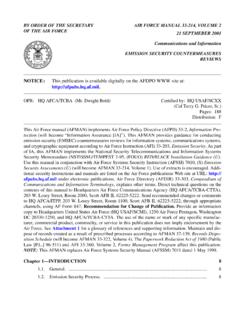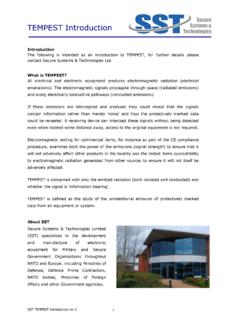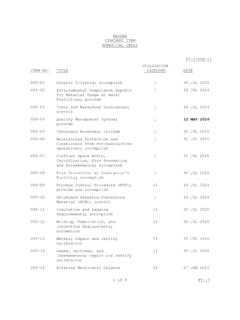Transcription of BY ORDER OF THE AIR FORCE INSTRUCTION 33 …
1 NOTICE :This publication is available digitally on the SAF/AAD WWW site at: you lack access, contact your Publishing Distribution Office (PDO).COMPLIANCE WITH THIS PUBLICATION IS MANDATORYBY ORDER OF THE SECRETARY OF THE AIR FORCEAIR FORCE INSTRUCTION 33-2031 MAY 1998 Communications and InformationEMISSION SECURITYOPR: HQ AFCA/GCIS (Dwight H. Bohl) Certified by: HQ USAF/SCXX (Lt Col Webb)Supersedes AFI 33-203, 1 January : 26 Distribution: FThis Air FORCE INSTRUCTION (AFI) implements the emission security (EMSEC) portion of Air FORCE PolicyDirective (AFPD) 33-2, Information Protection, and establishes Air FORCE EMSEC requirements forinformation protection (IP). It interfaces with Air FORCE Systems security INSTRUCTION (AFSSI) 4100, (C)Communications security Program (U) (will convert to AFI 33-201), AFSSI 5100, The Air FORCE Com-puter security (COMPUSEC) Program (will convert to AFI 33-202), AFSSI 5102, Computer security (COMPUSEC) for Operational Systems (will convert to AFI 33-202), and AFI 33-204, Information Pro-tection security Awareness, Training, and Education (SATE) Program.
2 We encourage you to use recommended changes or comments to Headquarters Air FORCE Communications Agency (HQAFCA/XPXP), 203 W. Losey Street, Room 1060, Scott AFB IL 62225-5233, through appropriate chan-nels, using AF Form 847, Recommendation for Change of Publication, with an information copy toHQ AFCA/GCI, 203 W. Losey Street, Room 2040, Scott AFB IL 62225-5234, and Headquarters AirForce Communications and Information Center (HQ AFCIC/SYNI), 1250 Air FORCE Pentagon, Washing-ton DC 20330-1250. The Glossary of References and Supporting Information is at Attachment OF REVISIONSThis document was substantially revised and must be completely reviewed. This revision was sub-stantially rewritten to change the emphasis for EMSEC from a stand-alone program to an integral part ofIP.
3 It deletes references to acquisition (paragraph 2), and implements the EMSEC certification part of thecertification and accreditation process (paragraph 9). It also clarifies application of the INSTRUCTION tothose contractors who contract to perform Air FORCE functions (paragraph 2). It clarifies the threeEMSEC assessments (paragraph ) and three EMSEC countermeasures reviews (paragraph 5), andthe process to authenticate them (paragraphs , , 6, 8, and 9). It adds the basic steps for validatingEMSEC countermeasures reviews (paragraph 6), adds the requirement for the user to notify the wing IPoffice to make the EMSEC inspection (paragraph ), and removes the annual requirement for EMSEC inspections (paragraph 8). It provides instructions for the EMSEC certification (paragraph 9) andremoves the INSTRUCTION for a reassessment during an annual inspection (paragraph 8).
4 It makes one levelof authority for approving temporary waivers (paragraph ). It replaces reference to the termReport Documentation PageReport Date 01 May 1998 Report Type N/ADates Covered ( to) - Title and Subtitle Air FORCE INSTRUCTION 33-203, Communications andInformation Emission SecurityContract Number Grant Number Program Element Number Author(s) Project Number Task Number Work Unit Number Performing Organization Name(s) and Address(es) Secretary of the Air FORCE Pentagon Washington, DC20330-1250 Performing Organization Report Number AFI33-203 Sponsoring/Monitoring Agency Name(s) and Address(es) Sponsor/Monitor s Acronym(s) Sponsor/Monitor s Report Number(s) Distribution/Availability Statement Approved for public release, distribution unlimitedSupplementary Notes Abstract Subject Terms Report Classification unclassifiedClassification of this page unclassifiedClassification of Abstract unclassified Limitation of Abstract UUNumber of Pages 262 AFI33-203 1 MAY 1998 command, control, communications, and computer (C4) with information systems.
5 It deletes AirForce Communications security (AFCOMSEC) Form 7001, emission security Assessment/EmissionSecurity Countermeasures Review, from being prescribed by this publication (it is now prescribed byAFSSI 7010, [S] The emission security Assessment [U]).Section AThe emission security .. security Requirements.. security Process.. security Assessments.. security Countermeasures Reviews .. Requirements.. Countermeasures.. security Inspection.. security Certification.. Requirements..5 Section and Authority..6 Section CQualifications and TEMPEST Technical Authority.. Guidance.. Prescribed: ..12 Attachment 1 GLOSSARY OF REFERENCES AND SUPPORTING INFORMATION 13 Attachment 2 THE emission security FLOW CHART 17 Attachment 3 PROCEDURES FOR COMPLETING AFCOMSEC FORM 3331 FOR A TEMPORARY WAIVER 20 Attachment 4 PROCEDURES FOR COMPLETING AFCOMSEC FORM 3331 FOR A PERMANENT WAIVER 24 AFI33-203 1 MAY 19983 Section A The emission security Introduction.
6 The Air FORCE EMSEC process has experienced many changes. Although thesechanges were attempts to meet the variances of a dynamic world, they require security protection mea-sures far beyond the needs of the average user. In the past, EMSEC tended to stand alone; however, IPnow requires a more balanced approach not only to the control of compromising emanations, NONSTOP,and HIJACK, but to communications security (COMSEC); COMPUSEC; and SATE as well. The primeobjective of EMSEC is to identify requirements from the standpoint of IP risk management principles andprovide the appropriate protection at the least possible, or no, cost. Key to this process is a partnershipbetween the wing IP office and the user. The wing IP office assesses the need for EMSEC as part of IP;determines the required countermeasures; advises commanders of vulnerabilities, threats, and risks; andrecommends a practical and feasible course of action to the wing commander.
7 The user applies emission security Requirements. Air FORCE organizations and contractors doing business as the AirForce, whether procuring or using systems to process classified national security information, must applyEMSEC proportional to the threat of They must consider the potential damage to national security if classified national security infor-mation is compromised, Assess the need for EMSEC for each aspect (control of compromising emanations, NON-STOP, and HIJACK) and determine the specific countermeasures before beginning architecturalengineering and facility design, procuring systems, or beginning engineering and Implement or apply required countermeasures before using systems to process classifiednational security Operate and maintain systems to preserve the integrity of required Processing classified national security information without complying with the above require-ments is a reportable security incident under AFI 31-401, Managing the Information security Pro-gram, except as allowed for by waiver in paragraph emission security Process.
8 Assess equipment and facilities to determine the need for EMSEC (con-trol of compromising emanations, NONSTOP, and HIJACK); determine, validate, and implement orapply the required countermeasures; and periodically reassess EMSEC requirements. The followingparagraphs further define this process (see Attachment 2).4. emission security Assessments. This process determines the need for EMSEC for a system that pro-cesses classified national security The using Air FORCE organization determines if the system will process classified national secu-rity If the system will process classified national security information, the using organization mustcontact the wing IP The wing IP office makes the EMSEC assessment for wing-level systems and 1 MAY The major command (MAJCOM) IP office makes the EMSEC assessment for MAJ-COM-level The lead MAJCOM IP office, or the certified TEMPEST technical authority (CTTA),makes the EMSEC assessments for Air FORCE -level For Special Category (SPECAT)
9 Information, the CTTA makes the EMSEC All IP Use AFSSI 7010 to make the Document the EMSEC assessment on AFCOMSEC Form 7001 according to AFSSI emission security Countermeasures Reviews . This process determines the needed control of com-promising emanations, NONSTOP, and HIJACK countermeasures for a system that processes classifiednational security If the EMSEC assessment determined the need for the control of compromising emanations,NONSTOP, or HIJACK, make the appropriate countermeasures review. Use Air FORCE Systems Secu-rity Memorandum (AFSSM) 7011, The emission security Countermeasures Review to make The same IP office that made the EMSEC assessments makes the EMSEC Whenever possible, document the EMSEC countermeasures reviews on the same AFCOMSECForm 7001 used for the EMSEC assessments.
10 Where this is not possible, complete an additionalAFCOMSEC Form 7001 for the countermeasures review with an appropriate reference to the associ-ated Validation Requirements. The CTTA must validate the EMSEC countermeasures review because ofthe costs involved in applying countermeasures to some facilities and the cost of some EMSEC countermeasures reviews according to AFSSM 7011. Whenever possible, document thevalidation on the same AFCOMSEC Form 7001 used for the EMSEC countermeasures review. Wherethis is not possible, complete an additional AFCOMSEC Form 7001 for the validation with an appropriatereference to the associated assessment and countermeasures Applying Countermeasures. The user applies, implements, and maintains the required countermea-sures identified by the EMSEC countermeasures review.
















